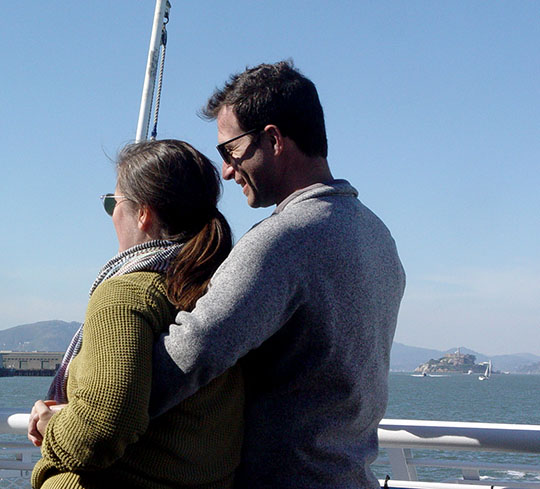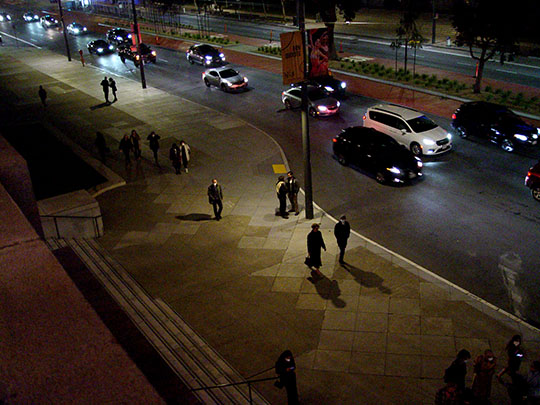Two weeks ago, the San Francisco Conservatory of Music presented La Clemenza di Tito in the best production of Mozart's problematic last opera that I have ever seen. The genius young director, James Darrah, and his collaborators (co-director Raviv Ullman, production designer Steven C. Kemp, costume designer Molly Irelan, and lighting designer Pablo Santiago), were all in top form, breathing life into a static opera seria with flair, humor, and intelligence. They also inspired the student singers into assured, bravura performances, something I have never experienced at the SF Conservatory before.
The Roman Empire setting was updated to early 20th Century Media Empire, with Tito standing in for a Hearst or Howard Hughes type of mogul. During the overture, a silent newsreel prologue was projected, detailing the breadth of the empire ("Newspapers! Movies! Television!") and introduced the characters who are possible Empress choices for Tito. The opera played out in a small, tiered, luxurious screening room facing the audience, with two walls flanking it onstage that hosted a range of projections that were alternately abstract, live video, or pre-shot film.
It was the most creative use of projected imagery I have seen on an opera stage, and all the more potent for not being overused. The plot springs into action with Vitellia, played by the huge-voiced Em McAllister above, seducing Tito's best friend Sesto into an assassination plot as vengeance for being spurned in the Empress selection process. The Capitol/Studio is set on fire and in a coup de theatre the curtain opens on Act Two with the screening room set trashed and burnt.
Tito survives, however, and there is a happy finale where the principals and chorus sing a paean to Tito praising his magnanimous clemency after he pardons Sesto and Vitellia for their treachery.
The student singers were all superb, at different levels of achievement. From left to right, soprano Monica Slater as Servilia sang her two arias with pure beauty. Lindsay Martin as Annio was a hilarious stage presence who looked outrageously striking in her outfit even though she was playing a man. Hope Nelson as Sesto gave a hell for leather performance vocally and dramatically, and just about ran away with the show. Jackson Allen as Tito was a perfect smooth young mogul, surrounded by cameras and bodyguards as if he was born to it, and he negotiated the difficult music well.
Mozart wrote the opera fast on a commission in 1791 for a royal political event in Prague to celebrate the coronation of Leopold II, Holy Roman Emperor, as King of Bohemia. The libretto was a slapped-together affair of earlier operatic settings of the same story. The music, however, is as great as anything Mozart ever wrote, and to hear it live and performed with such conviction was a joy. The playing of the 28-person student orchestra was delightful, with a special standout in Lindsey Ha on the clarinet and basset horn. The conducting by Curt Pajer (above center in the tuxedo) was terrific Mozart.
Though the theme is about the benevolence of an autocrat, director James Darrah had other ideas, and came up with a subversive ending, where Tito proclaims his clemency while Vitellia and Sesto are sitting in the front chairs gagged and hooded, Guantanamo style. Meanwhile, two characters arrive dressed in the same costumes and become the new Vitellia and Sesto for the cameras, rather like favorite soap opera characters being swapped out with a new actor. Because this production was double cast for its two performances, Darrah was able to use Rayna Mia Campbell as the New Vitellia and Stella Hannock as the New Sesto, and they sang in the final ensemble in place of the originals. The doubling also extended to the role of Publio, Commander of the Bodyguards, who was sung by the basses Will O'Brien on Friday night and Dante Mireles on Sunday afternoon, with one being a silent supernumerary for the other in both performances.
I returned for the second cast on Sunday afternoon because I was so enthralled with the production. The second cast had different strengths and weaknesses from the first, but they were all very good too. Leah Finn (above) as Annio was more boyish than her predecessor, less funny and more serious, which was true as well of Stella Hannock as Sesto. Chea Kang's voice was so gorgeous as Servilia that you wished she had more than two arias. In an interesting gender switch, Tito was played by Emily Tate Daniel who was a completely convincing, swaggering narcissist. Dante Mireles (above) won the bass competition as Publio, but he and Will O'Brien worked well together in both shows.
The other reason I went back to the second performance was because Rayna Mia Campbell as the New Vitellia made my ears tingle in the finale. As the Original Vitellia on Sunday afternoon, she surpassed expectations with a dramatic, seductive command of the stage and a voice that is probably going to be heard in major opera houses all over the world. She is a major talent.
Saturday, March 26, 2022
Tuesday, March 22, 2022
Nikola Printz En Travesti
A week ago, the mezzo-soprano Nikola Printz was featured at the Merola Opera Program's first Schwabacher recital series since the pandemic began, and they had a blast playing with gender and an unusual, wide-ranging repertory. She began with a 17th century song by Barbara Strozzi, Lagrime mie, accompanied by Jon Mendle on the theorbo. This was followed by a trio of songs by Rossini, La Regatta Veneziana, where a woman on a balcony urges her gondolier lover to victory in a boat race in the Venetian canals.
Printz was accompanied through most of the program by the pianist Erica Xiaoyan Guo, continuing with the 19th century Licht in der nacht by Alma Mahler which segued without pause into the 20th century lament, I was a woman from David Lang's 21st-century prisoner of the state, It was a strange, effective combination. While Printz changed outfits from the "Femme" portion of the program into the "Masculine", Erica Xiaoyan Guo played the lovely Etude in F-sharp Minor by Louise Farrenc, a 19th century French composer who was a welcome new discovery for me.
Printz returned with a trio of miniature songs by the still-living Ned Rorem set to short poems by Walt Whitman and Gertrude Stein, a remarkably queer triple play. This was followed by two Schubert lieder, Standchen from Schwanengesang and Schubert's Der Leiermann from Winterreise.
The highlight of the concert for me was Printz singing a pair of Mexican songs, Aquel amor by Agustin Lara and No soy de Aqui by Facundo Cabral that were popularized by the great ranchera singer, Chavela Vargas, a Mexico City street singer who lived long enough to become an international legend. If you have never heard Vargas, click here for her version of No Soy de Aqui.
After intermission, Printz returned in a bright fuschia jacket for the "Neutrois" section of the program that included Drei Lieder Korngold and Cabaret Songs by Britten with tricky, nonsense-verse texts by W.H. Auden. The fuschia jacket was discarded early in the set "because it's too hot," and for a finale Printz kicked off their shoes as they sat down to the piano and accompanied themself on Prince's Nothing Compares 2 U. Art song recitals are not really my cup of tea, but I've been following Printz in performances around the Bay Area over the last decade, and they are always interesting to watch. It was nice to see this artist under the auspices of the San Francisco Opera Center.
Printz was accompanied through most of the program by the pianist Erica Xiaoyan Guo, continuing with the 19th century Licht in der nacht by Alma Mahler which segued without pause into the 20th century lament, I was a woman from David Lang's 21st-century prisoner of the state, It was a strange, effective combination. While Printz changed outfits from the "Femme" portion of the program into the "Masculine", Erica Xiaoyan Guo played the lovely Etude in F-sharp Minor by Louise Farrenc, a 19th century French composer who was a welcome new discovery for me.
Printz returned with a trio of miniature songs by the still-living Ned Rorem set to short poems by Walt Whitman and Gertrude Stein, a remarkably queer triple play. This was followed by two Schubert lieder, Standchen from Schwanengesang and Schubert's Der Leiermann from Winterreise.
The highlight of the concert for me was Printz singing a pair of Mexican songs, Aquel amor by Agustin Lara and No soy de Aqui by Facundo Cabral that were popularized by the great ranchera singer, Chavela Vargas, a Mexico City street singer who lived long enough to become an international legend. If you have never heard Vargas, click here for her version of No Soy de Aqui.
After intermission, Printz returned in a bright fuschia jacket for the "Neutrois" section of the program that included Drei Lieder Korngold and Cabaret Songs by Britten with tricky, nonsense-verse texts by W.H. Auden. The fuschia jacket was discarded early in the set "because it's too hot," and for a finale Printz kicked off their shoes as they sat down to the piano and accompanied themself on Prince's Nothing Compares 2 U. Art song recitals are not really my cup of tea, but I've been following Printz in performances around the Bay Area over the last decade, and they are always interesting to watch. It was nice to see this artist under the auspices of the San Francisco Opera Center.
Friday, March 11, 2022
Head West, Senior Rescue Dog
Head West is a "makers" elevated crafts marketplace that started in 2017 in the East Bay and then spread to locations in Sebastopol, the Hangar 1 distillery in Alameda, and the back of the San Francisco Ferry Building on intermittent weekend dates. (Click here for schedule.)
There were many booths selling upscale candles, vintage and newly designed clothing...
...and trinkets of all sorts. The most popular booth was Muttville...
...where a half dozen small senior dogs were being displayed for possible adoption.
"Are they trying to break everyone's hearts?" I asked the women holding one of the rescues. "Yes!" she replied.
There were many booths selling upscale candles, vintage and newly designed clothing...
...and trinkets of all sorts. The most popular booth was Muttville...
...where a half dozen small senior dogs were being displayed for possible adoption.
"Are they trying to break everyone's hearts?" I asked the women holding one of the rescues. "Yes!" she replied.
Sunday, March 06, 2022
The Flaming Phoenix Arises at the San Francisco Symphony
An extraordinary world premiere opened the San Francisco Symphony's concerts last week. The Chinese-born, South Carolina-living composer Fang Man was commissioned to write a work by Music Director Esa-Pekka Salonen that could be paired with the rarely performed Franz Liszt "symphonic poem" Prometheus. The result was the 25-minute Song of the Flaming Phoenix, which is one of the wildest, most original pieces of music I have ever heard. It felt like an historic occasion.
The composer was interviewed onstage on Friday evening by conductor Esa-Pekka Salonen right before the second performance of her concerto, and she gushed with such emotion and pleasure at the work of the orchestra, Salonen, and her soloist Wu Wei that I didn't think they would get her off the stage.
In an interview in the program, Fang Man says: "Esa-Pekka gave me this huge orchestra to write for. I was just thrilled when I saw the instrumentation...a total of over 90 musicians. How many times does a composer get to write for such a large orchestra? I love composing for the orchestra; I have an absolute passion for it." Boy, does she ever, composing a work with its own internal logic that is loud, rhythmically percussive, and marvelously inventive in its use of every instrument in the orchestra.
Wu Wei is the current global master of one of the world's oldest instruments, the sheng, a mouth organ composed of bamboo pipes encased in metal. Fang Man began the work writing the solo concerto part, and it's beyond virtuosic, and so was Wu Wei's performance. What was astonishing throughout was that the instrument which variously sounds like a harmonica, an organ, an accordion, and a theremin managed to pierce through the wall of sound from the 90-piece orchestra. It was amazing. Whether somebody loved or hated the piece, everybody walked into intermission going, "Wow, that was something!"
The second half resumed with Liszt's Second Piano Concerto with the soloist Jean-Yves Thibaudet, who I had never seen before but his legend preceded him. Possibly because of affairs in the world, the performance by orchestra and soloist sounded martial, in a Hungarian Idependence way that Liszt sometimes channeled. I wouldn't want to hear it played that way all the time, but it was an exciting and skillful performance.
Dessert was provided by Scriabin's The Poem of Ecstasy for the 90+ musicians. The piece reminds me of Strauss's Also Sprach Zarathustra, where there is two minutes of anthemic, transcendent, climactic music and 25 minutes of driveling around. In the Strauss, the good part comes at the beginning. In the Scriabin, it comes at the end, and we walked out of Davies Hall vibrating from its massive sound.
In an interview in the program, Fang Man says: "Esa-Pekka gave me this huge orchestra to write for. I was just thrilled when I saw the instrumentation...a total of over 90 musicians. How many times does a composer get to write for such a large orchestra? I love composing for the orchestra; I have an absolute passion for it." Boy, does she ever, composing a work with its own internal logic that is loud, rhythmically percussive, and marvelously inventive in its use of every instrument in the orchestra.
Wu Wei is the current global master of one of the world's oldest instruments, the sheng, a mouth organ composed of bamboo pipes encased in metal. Fang Man began the work writing the solo concerto part, and it's beyond virtuosic, and so was Wu Wei's performance. What was astonishing throughout was that the instrument which variously sounds like a harmonica, an organ, an accordion, and a theremin managed to pierce through the wall of sound from the 90-piece orchestra. It was amazing. Whether somebody loved or hated the piece, everybody walked into intermission going, "Wow, that was something!"
The second half resumed with Liszt's Second Piano Concerto with the soloist Jean-Yves Thibaudet, who I had never seen before but his legend preceded him. Possibly because of affairs in the world, the performance by orchestra and soloist sounded martial, in a Hungarian Idependence way that Liszt sometimes channeled. I wouldn't want to hear it played that way all the time, but it was an exciting and skillful performance.
Dessert was provided by Scriabin's The Poem of Ecstasy for the 90+ musicians. The piece reminds me of Strauss's Also Sprach Zarathustra, where there is two minutes of anthemic, transcendent, climactic music and 25 minutes of driveling around. In the Strauss, the good part comes at the beginning. In the Scriabin, it comes at the end, and we walked out of Davies Hall vibrating from its massive sound.
Friday, March 04, 2022
Sausalito Selfies
Playing tourist in my own city, I took a boat ride to Sausalito last Sunday afternoon.
The tourists on the ferryboat were mostly speaking languages other than English. I heard Spanish, French, Hebrew, Russian, German, Tagalog, and who-knows-which-Scandinavian languages. The best bet for an inexpensive lunch is to get a sandwich at Venezia, an Italian deli on Bridgeway now run by Spanish speakers. You can take the sandwich to go, walk across the street to the breakwater, and watch people take pictures of each other while framed by a spectacular view.
On Sunday, a Pedro Aldomovar movie broke through into real life as three women delightedly posed for each other in fabulous outfits.
We were afraid that might tip over from the narrow ledge into the bay, especially with their stylish shoes...
...but they seemed fearless...
...and sublimely unselfconscious of everyone else around them.
On the boat ride back, there were young lovers giving off a glow...
...among them my favorite happy couple of the day.
The tourists on the ferryboat were mostly speaking languages other than English. I heard Spanish, French, Hebrew, Russian, German, Tagalog, and who-knows-which-Scandinavian languages. The best bet for an inexpensive lunch is to get a sandwich at Venezia, an Italian deli on Bridgeway now run by Spanish speakers. You can take the sandwich to go, walk across the street to the breakwater, and watch people take pictures of each other while framed by a spectacular view.
On Sunday, a Pedro Aldomovar movie broke through into real life as three women delightedly posed for each other in fabulous outfits.
We were afraid that might tip over from the narrow ledge into the bay, especially with their stylish shoes...
...but they seemed fearless...
...and sublimely unselfconscious of everyone else around them.
On the boat ride back, there were young lovers giving off a glow...
...among them my favorite happy couple of the day.
Tuesday, March 01, 2022
Don Quixote at the SF Ballet
On Saturday, San Francisco Ballet revived their production of Don Quixote, an 1869 Russian Grand Ballet with choreography by Marius Petipa and music by Ludwig Minkus. The French-born Petipa was the most influential choreographer of the second half of the 19th century from his perch as Ballet Master of the St. Petersburg Imperial Theatres. Minkus was a Viennese violinist and composer who took a job in the orchestra at the Bolshoi and eventually made his way to being Official Composer of the St. Petersburg Imperial Theatres. Somehow I have gone through life without seeing a single one of their famous collaborations, and it was odd to attend my first last Saturday evening while Russia was invading Ukraine.
Whenever Minkus is mentioned in reviews of ballet productions, his music is usually affectionately dismissed. The score to Don Quixote is total schlock, a Viennese Jew writing French ballet music for a Russian audience while embroidering it with Spanish touches. It's also outrageously fun, eminently danceable schlock, one bouncy tune after another. Minkus retired in the early 1890s and moved back to Vienna with a small pension from Russia but he lived into his early 90s and World War I intervened. The sad finale to his Wikipedia entry is: "Minkus later relocated to an apartment in the Gentzgasse where he spent his final years alone and in utter poverty, his wife having died in 1895, and the events of World War I having cut off his pension from Russia." It seems that a pension from Russia has always been a precarious proposition. Don Quixote has never been one of my favorite stories, from the novel to various operas to Man of La Mancha, so it was a delight to find that in this ballet, Don Quixote and Sancho Panza are minor comic characters who wander through a town where everyone dances, all the time.
Jim Sohm and Pascal Molat were extraordinary young dancers in the 1970s and 1980s at SF Ballet, and it was a treat to see they could still move so beautifully. As the Don and Sancho, their comic schtick throughout the evening was sweet, understated and occasionally even funny. (All production photos by Erik Tomasson.)
The real leads are a young couple, danced by Angelo Greco and Misa Kuranaga, who go through a few slight obstacles on their way to being wed. They rocked their red outfits and the white ones in the third act too. The original SF Ballet Helgi Tomasson production is from 2003 but he upgraded the sets and costumes in 2012 with designer Martin Pakledenaz, who was dying of a brain tumor. Heather Lockard, his Associate Costume Designer, needs her own accolade because the costumes were some of the most strikingly beautiful I've seen at the ballet.
On top of 152 separate roles, there were other couples galore, including my favorite dancer of the evening, Esteban Hernandez, as King of the Gypsies...
...and his Queen of the Gypsies, Ellen Rose Hummel, who looked like she was channeling Martha Graham at certain moments.
Sarah Van Patten, who has just announced her retirement, was my favorite ballerina of the evening, and Luke Ingham looked smashing as her toreador.
The entire production is surprisingly entertaining, and the audience enjoyed it with an almost-post-Covid-infused intensity. It's playing all this week with rotating casts. Personal favorite, Joseph Walsh, in Cast #2.
Whenever Minkus is mentioned in reviews of ballet productions, his music is usually affectionately dismissed. The score to Don Quixote is total schlock, a Viennese Jew writing French ballet music for a Russian audience while embroidering it with Spanish touches. It's also outrageously fun, eminently danceable schlock, one bouncy tune after another. Minkus retired in the early 1890s and moved back to Vienna with a small pension from Russia but he lived into his early 90s and World War I intervened. The sad finale to his Wikipedia entry is: "Minkus later relocated to an apartment in the Gentzgasse where he spent his final years alone and in utter poverty, his wife having died in 1895, and the events of World War I having cut off his pension from Russia." It seems that a pension from Russia has always been a precarious proposition. Don Quixote has never been one of my favorite stories, from the novel to various operas to Man of La Mancha, so it was a delight to find that in this ballet, Don Quixote and Sancho Panza are minor comic characters who wander through a town where everyone dances, all the time.
Jim Sohm and Pascal Molat were extraordinary young dancers in the 1970s and 1980s at SF Ballet, and it was a treat to see they could still move so beautifully. As the Don and Sancho, their comic schtick throughout the evening was sweet, understated and occasionally even funny. (All production photos by Erik Tomasson.)
The real leads are a young couple, danced by Angelo Greco and Misa Kuranaga, who go through a few slight obstacles on their way to being wed. They rocked their red outfits and the white ones in the third act too. The original SF Ballet Helgi Tomasson production is from 2003 but he upgraded the sets and costumes in 2012 with designer Martin Pakledenaz, who was dying of a brain tumor. Heather Lockard, his Associate Costume Designer, needs her own accolade because the costumes were some of the most strikingly beautiful I've seen at the ballet.
On top of 152 separate roles, there were other couples galore, including my favorite dancer of the evening, Esteban Hernandez, as King of the Gypsies...
...and his Queen of the Gypsies, Ellen Rose Hummel, who looked like she was channeling Martha Graham at certain moments.
Sarah Van Patten, who has just announced her retirement, was my favorite ballerina of the evening, and Luke Ingham looked smashing as her toreador.
The entire production is surprisingly entertaining, and the audience enjoyed it with an almost-post-Covid-infused intensity. It's playing all this week with rotating casts. Personal favorite, Joseph Walsh, in Cast #2.
Subscribe to:
Comments (Atom)














































